How to lay an air conditioner route: specifics of the communications device
It is difficult to imagine modern comfortable housing without an air conditioning system.Agree that it is not enough to simply purchase equipment with the appropriate parameters, but you also need to know how to lay the air conditioner route for its normal operation.
Installing air conditioning and split systems is no longer a rarity; they are found in almost every home. A correctly laid route will ensure reliable connection of elements and ensure the most efficient operation of the equipment, significantly extending its service life.
We will understand all the intricacies of laying the route and the nuances of the work. Let's consider tracing methods that allow you to preserve the design of the room even when the work is carried out after finishing renovations.
The content of the article:
What is an air conditioner route?
Each split system consists of at least two modules, external and internal. The number of internal modules is determined by the power of the equipment and depends on the area of the room.
All modules are connected to each other by a system of pipelines that ensure the movement of refrigerant and drainage of condensate.
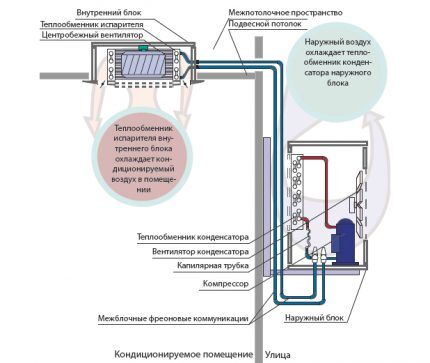
In addition to the piping, all modules are connected by a cable that provides power and control. It is this cable and pipeline connecting all the modules that is called the air conditioner route.
Where does route installation begin?
It is best to begin work on laying air conditioner communications after purchasing the equipment or at least after selecting the required model. The defining component of any route is the diameter of the tubes, which depends on the model.
In addition, each of the air conditioner models has its own maximum values for the length of the route. The maximum length of the air conditioner route when using wall-type household split systems does not exceed 20 meters. This does not mean that the system will not function. Simply exceeding the limit threshold can significantly reduce the performance of the air conditioner.
What should you consider before laying a route?
Even before starting work, it is important to determine the exact location installation of cassette air conditioners, duct and multiblock systems, since it will be impossible to move the air conditioner even a couple of centimeters.
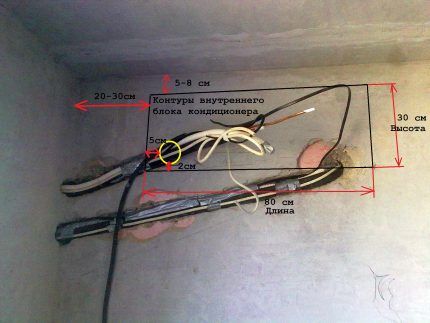
The external unit should be positioned in such a way as to provide easy access for cleaning and maintenance without the use of special equipment.
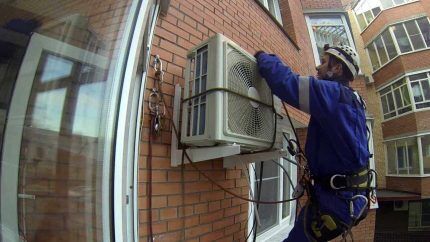
The power of the air conditioner places a significant load on electrical communications, so it is recommended to lay a separate supply line with its own circuit breaker. Before starting tracing, it is necessary to select the most optimal location for installing the indoor unit and calculate the length of the line.
When placing equipment, the following features must be taken into account:
- You cannot go beyond the height limits of the indoor and outdoor units. For household appliances, this figure is within 7-12 meters.
- When laying drainage, you need to maintain an angle of inclination so that condensate flows freely into the sewer. This requirement can be neglected if the drainage system is equipped with a pump, during which the condensate is simply pushed out.
- The distance from the ceiling to the top of the indoor unit must be at least 10 cm. This space is necessary to ensure normal air circulation.
- Even before installing the air conditioner, you need to consider the location of the furniture, since the flow of cold air should not be directed directly at people.
- The equipment should not be placed directly above the bed in the bedroom, as the air conditioner cannot operate completely silently.
Taking into account all the above features, you can begin laying the main line and carrying out installation work.
Sequence of work
Lack of skills to carry out work is not a reason to refuse to lay the route yourself. Knowing the operating principle of the equipment and having a set of tools in your arsenal, you can easily install the air conditioner yourself.
In addition to the equipment, you will need the following materials:
- Copper tubes of the appropriate diameter with brass nuts;
- Thermal insulation material;
- Sealant.
Protective equipment will not hurt, since when chipping walls, even using a household vacuum cleaner, there will be a lot of dust.And when refilling the air conditioner with refrigerant, it may leak, which can negatively affect the respiratory system.
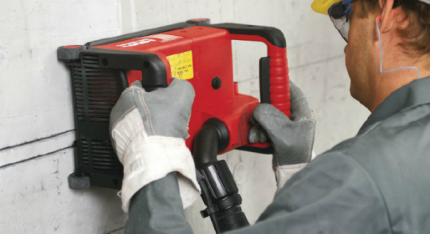
The preparatory stage is the most important, since it is at this stage that it is necessary to correctly orient the placement of blocks and elements of the route.
The work is performed in the following order:
- Marking on the wall for the location of the indoor unit;
- Marking grooves in walls taking into account slopes;
- Drilling holes in walls;
- Laying pipes for refrigerant;
- Laying a drainage pipe;
- Electrical cable laying and installation air conditioner sockets;
- Drilling a hole in the wall to connect the indoor unit.
This order of work is the most complicated, but at the same time it is considered the most practical, as it allows you to maintain a decent aesthetic appearance of the room. The pipes to the indoor unit are mounted into the wall and enter from the back, leaving only one plastic panel visible.
It should be taken into account that the gating method is more labor-intensive and expensive.
Choosing a route arrangement method
There are two ways to lay a route for a split system - installing communications in walls or boxes.
Installation in a box has a number of advantages:
- Reduced labor intensity. Attaching the box to the wall is much easier and faster than gating.
- No dust. When working with a grinder or wall chaser, it is impossible to avoid dust in the room.
- Speed of work. You can drill holes and secure the box in just a couple of hours, but it can take more than one day to ditch the route if we are talking about installing several split systems and their significant distance from the external unit.
At first it may seem that the box arrangement looks preferable. However, in fact, all these advantages outweigh the disadvantages, which cannot be neglected.
The significant disadvantages are that:
- The drainage route must be inclined towards the drain by no less than 3 degrees. With a standard height of 3 m, the slope should already be at least 9 cm, and such a distortion will be too conspicuous, disturbing the aesthetic appearance of the room.
- One box is not enough. The pipe and electrical cable must be hidden in separate boxes placed parallel to each other. Thus, part of the wall will be occupied, which complicates the resolution of issues when carrying out cosmetic repairs, using hanging furniture and decorative elements.
- If it is necessary to drain drainage into the sewer system, the box will have to be laid through all rooms of the apartment or house.
After considering all the weaknesses of each method, it becomes obvious that the disadvantages of hidden installation are not so significant.
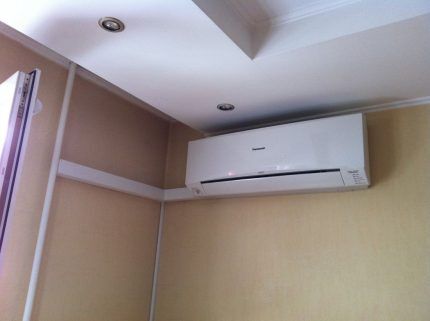
If the pipe laying work is carried out with high quality and standards are followed, you don’t have to worry about compromising the integrity of the system and the need for repairs.
Construction of an air conditioner route
The first stage of work on installing the route to connect the split system with the external unit is the marking of the groove. It can be performed in various ways.
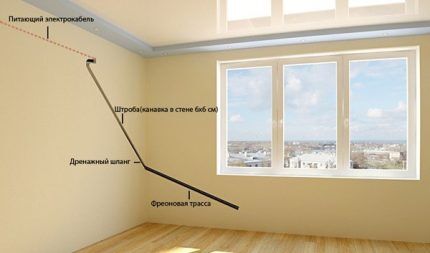
When marking, it is necessary to take into account the location of other communications in order to avoid their possible intersection or damage.
The procedure for gating
The method of marking the grooves depends on the characteristics of the drainage system and the location of the condensate drain:
- If the drainage and freon pipes are located parallel, the recess should be made with a slope of at least 3 degrees to prevent stagnation of condensate.
- If the drainage pipe is located separately with condensate drainage into the sewer system, then a slope is required only for drainage. The refrigerant line can be positioned without slopes and placed either on the wall or on the ceiling.
- If it is not possible to move condensate by gravity, it is necessary to install additional pumping equipment.
After drilling a hole in the wall to connect the route to the already installed outdoor unit you can start marking the route by moving from the hole in the wall to the lower corner of the block located indoors. When making turns, avoid sharp bends. It is best to keep the slope constant throughout the entire length of the highway.
To ensure an even groove in the wall, it is better to cut the edges using an angle grinder before starting the groove. After this, you can perform gating using a hammer drill.
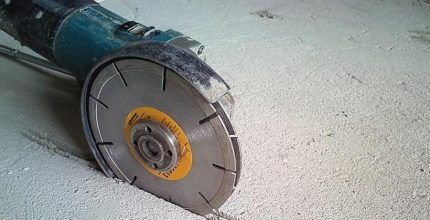
Usually it is enough to make a groove 6 cm deep. If necessary, you can reduce the depth by half, but at the same time expand the groove to 8 cm. In this case, communications will be laid in the furrow not in depth, but in width.
Calculation of required materials
For household appliances with a power of up to 3 kW, depending on the model, copper pipes are used to install the air conditioner route with a diameter of 1/4 or 3/8 inch, which corresponds to 6 and 10 mm.
When calculating the length of the tube, you should take into account the distance under the indoor block of about half a meter, the thickness of the walls, the length of the groove, the distance from the outside of the wall to the block taps. It is also better to make the length of the pipe at least half a meter on the outside to ensure a smooth bend.
The size of the electrical cable is calculated in a similar way. The only difference is that the length under the internal block is about 1.2 m, and the length outside is 0.2-0.3 m longer than the tubes. It would not be superfluous to provide for laying an additional cable that can be used to connect additional sensors.
For the installation of a drainage line, it is preferable to use a corrugated hose with a diameter of 16 mm. Calculating the length is similar to calculating the length of the pipeline, taking into account the length under the indoor unit is about 0.5 m, the length outside is about 1.2 m.
Features of route installation
It is best to start laying the route from the edge that faces the street. We form a bundle from tubes and electrical cables, put flex on it and wrap it with tape for the part of the length that will pass through the wall. This is necessary to prevent damage to the insulation.

After this, the harness must be pulled through the wall, taking into account the length of the outer part, calculated earlier.
Next, all materials must be placed in the groove, observing the following rules:
- The drainage hose should be located at an angle along the entire length of the route;
- The drainage should be located to the left of the tubes at the outlet of the groove when connected to the indoor unit;
- Copper tubes with a diameter of up to 10 mm can be carefully bent by hand. For larger diameter pipes, a pipe bender must be used.
- The route laid in the groove must be secured using mounting tape and secured with dowels. It is necessary to ensure that communications do not protrude beyond the groove, as this can cause difficulties during finishing work.
- To check the route, it is advisable to perform pressure testing of the system - pumping nitrogen from a cylinder under pressure. This will help check the integrity of the system and the tightness of the installation.
After pressure testing, you need to remove any remaining liquid from the system and you can connect the units and charge the refrigerant.
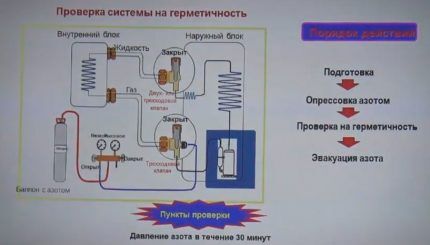
After checking the operation of the system, you can begin to close the groove with a building mixture.
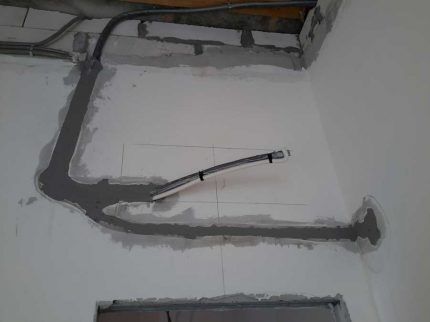
The building mixture must be selected depending on the material from which the walls are made.Cement-based mixtures are ideal for brick and concrete walls. He will introduce you to choosing the optimal time for installing an air conditioner. next article, which we advise all potential equipment buyers to read.
Conclusions and useful video on the topic
Rules for laying the air conditioner route, materials and equipment necessary for the work:
Laying the air conditioner route is a very important undertaking, since the performance and durability of the climate control equipment largely depends on the correct performance of the work. Most of the work can be done with your own hands; this does not require any special skills or special equipment.
If you go further, you can carry out pressure testing and refilling of the system yourself, but here you need to think carefully and decide whether it is worth spending money on purchasing additional equipment or resorting to the services of installers.
But the cost savings will already be obvious, because laying a route is quite an expensive undertaking, especially if gating is used and the pipes are hidden in the walls.
Would you like to share your own experience gained during the installation of an air conditioner route? Do you have useful information on the topic of the article that is worth sharing with site visitors? Please write comments in the block below, post photographs and ask questions about the topic of the article.




Hello. I'm going to hang an air conditioner above the bathroom door. Wall 95cm.Please tell me, is it possible to lay a freon route from the lower left corner of the indoor unit diagonally upward to the upper center of the indoor unit?